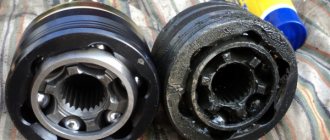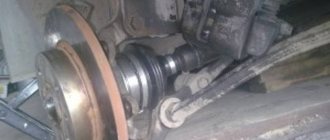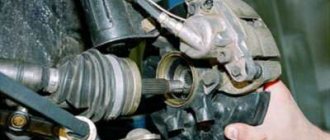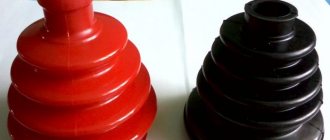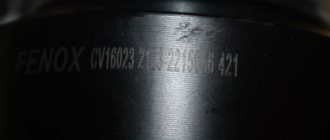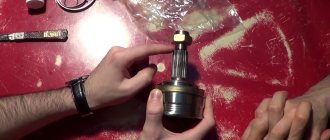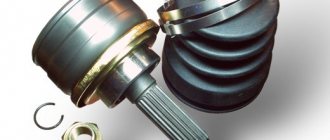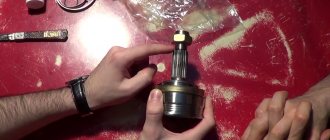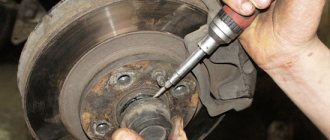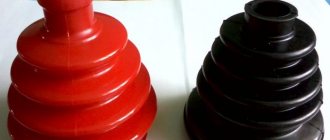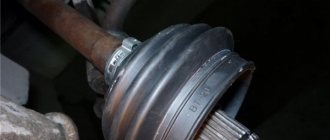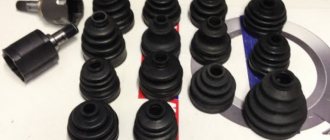The constant velocity joint (CV joint), or, as it is popularly called, a grenade, appeared at the moment when front-wheel drive cars began to be introduced onto the market, and its main task is to transmit command from the gearbox to the drive wheel. If you remember, in rear-wheel drive cars this function is performed by the cardan transmission. For a front-wheel drive car, such a mechanism will lead to an increase in its size, and, accordingly, the price will increase along with this.
As for the VAZ-2109, this model has two CV joints: external and internal.
And today we will talk about how to replace the outer boot for a given car with your own hands, since it is this that most often becomes deformed and torn.
Causes of CV joint failure
Unlike other cars, it is especially difficult for the VAZ-2109 to keep the grenade boot in working condition for a long period. The main reasons for its failure, first of all, can be unfavorable climatic and external factors. As a result, cracks will form on the parts, and further operation will be impossible. Through the torn mechanism, dust and dirt get inside the hinge, and because of this, the grenade parts wear out. It is not difficult to detect this: when the car is moving and when turning, the car makes a “crunching” sound, and this is already the first signal.
If, after you heard a suspicious crunch in your VAZ-2109, you came to the garage and found traces of grease on the hinge, then you immediately need to completely replace the CV joint along with the boot, since the parts of this mechanism cannot be interchanged.
What is the dust cover used for?
The outer boot of the CV joint reliably protects the elements of this mechanism from dust and dirt getting into it. It is made of durable, elastic rubber that is resistant to wear, temperature fluctuations and aggressive environments and can last quite a long time, but over time it will still crack or rupture.
If the outer boot breaks, dust and dirt get inside the grenade, acting as an abrasive. And since the moving parts of this mechanism work under high loads in different planes at different angles, this leads to rapid failure of the hinges. Therefore, it is necessary to monitor the integrity of the boot so that the CV joint does not break over several hundred thousand kilometers.
To replace the outer CV joint, follow the following procedure:
- We place the car on the inspection hole and support it with wheel chocks.
- Using a 30mm socket, loosen the hub nut. If the nut does not break off, then you can extend the key with a pipe.
- Raise the car with a jack in the right place and remove the wheel.
- We unscrew the bolts securing the ball joint of the lower arm to the hub.
- We squeeze out the tie rod end with a puller.
- Unscrew the drive shaft nut completely.
- We pull out the hub by grasping the brake disc and pulling the shock absorber strut towards us.
To change the boot and hinge, you will have to climb into the inspection hole. To remove the CV joint, remove the clamps that hold the boot. Next, we get rid of the old boot, which is easier to do with a knife. Use a rag to remove grease from the hinge. Then you need to knock down the inner race, for which we lightly hit the attachment with a hammer, which must be rested against the end of the hinge. Next, we thoroughly clean the CV joint from dirt, sand, dust and grease.
Shall we get started?
Before replacing the mechanism, you need to drain all the oil from the gearbox. Let's not touch the jack yet! You need to place a brick under the rear wheel of the car, after this procedure we take the 30 socket and, accordingly, loosen the nut. Don't be alarmed, you may need about a half meter long piece of pipe half a meter long as a lever. Remember, we only need to loosen the nut, not remove it yet!- Everything worked out? Go ahead! We lift the car with a jack, and only now completely remove the hub nut along with the washer. Now you can safely remove the wheel from the hub.
- Take the 13mm head and remove the two bolts that secure the ball to the hub. After this, we move the hub and remove the outer grenade from it. Then we attach a pry bar to the internal grenade and, using hammer blows, knock it out of the gearbox. By the way, if you still don’t have a pry bar at hand, a piece of pipe can replace it.
- When the grenade is removed, we clamp its shaft in a vice.
- We remove the clamps from the unusable boot. After that, we shoot down the outer grenade. Attention! In order not to damage it, you need to hit it along the edge. When this operation is completed, remove all old grease from the mechanism, wash it in gasoline or kerosene and wipe it well again, this way you can better remove traces of grease.
- Now we put a new boot on the drive shaft, and using a hammer we hammer the outer CV joint back, after thoroughly lubricating all the parts of the product. After that, we put it on and tighten it with a collar.
- Then we insert the grenade into the gearbox, driving it there. We place it in the hub and return the ball to its place. We put on the hub nut.
Attention! The hub nut does not need to be tightened with great force. After installing the wheels, tighten the bolts without applying much physical force.
- We remove the car from the jack, place a brick under the front wheel and tighten the nuts tightly.
- Well, now pour oil into the gearbox.
Replacement
If problems arise with grenades, you should determine which ones have problems. Next we will look at how to change the drive and how to remove it. Additionally, we recommend watching the repair manual video.
The procedure for replacing inner and outer CV joints differs from each other, therefore each stage should be considered separately.
Let's start with the internal.
Inner CV joint
Rubber boots are a vulnerable element of the grenade design. It is not uncommon that by replacing the boot, washing the grenade with gasoline and applying new lubricant, it is possible to solve the problem. If the wear of the CV joint is insignificant, such measures can replace a full repair.
But if you discover the breakdown late, you will have to completely replace the inner CV joints.
- Apply the handbrake and install chocks under the wheels.
- Unscrew the hub nut using a wrench and a socket. Carefully remove the punching elements from the nut with a punch. This way you will be able to preserve the carving on the garnet. The nut itself will need to be replaced with a new one during reassembly.
- The main thing here is to unscrew the nut, lowering the wheels to the ground. Otherwise, you risk breaking the differential and other gearbox components.
- Raise the car using a jack on the desired side, first loosening the wheel nuts. Remove the wheel.
- Drain the gearbox oil. This can be done earlier, at your convenience.
- Release the steering knuckle from the ball joint at the bottom. To do this, unscrew a pair of mounting bolts.
- Since you have already removed the hub nut and unscrewed the ball joint from the steering knuckle, proceed to removing the splined part of the grenade. To do this, pull the brake disc and strut assembly towards you. She has a decent ride. Just remember to turn the steering wheel all the way so that the tip of the steering wheel extends as far as possible.
- Pry the inner grenade with a pry bar, which will allow you to remove the drive.
- Having taken out the CV joint, look at the condition of the oil seal in the gearbox. If you find traces of leaks, be sure to replace the element.
The internal drive (CV joint) is designed to work with smaller angles, its boot is less susceptible to negative influences. Therefore, the internal grenade is changed quite rarely.
Outer CV joint
The outer grenade wears out more actively, so replacement is carried out more often.
Under no circumstances remove two CV joints from the gearbox at the same time. Otherwise, it will cause the gear to become misaligned. Remove one at a time or insert special inserts in place of the hinge.
- If you have extensive experience in such matters, it is quite possible to knock out an external grenade right under the car. This saves time and effort. But such a task requires increased attention and caution in actions.
- Ensure that the axle shaft is stationary or has limited movement. If this is not done, the axle shaft will move when the grenade clip is struck with a hammer. Because of this, the inner CV joint will simply come out of contact and split into parts inside the boot. Therefore, you will have to dismantle the unit completely, and this is a very difficult task.
- You can hold the axle shaft with your hands, but a more effective means is a hand vice or a gas wrench. It is better to enlist the support of a partner. This is the best option.
- Take a fairly heavy hammer with a short handle.
- If damaged, cut, turn or move the boot to the side so that it does not interfere with striking.
- The blows should be made sharp, but at the same time careful. There is no point in hitting the element with great force.
- Due to successive blows, the resistance of the locking ring should weaken, which will allow the outer grenade to be removed from the axle shaft.
- Thoroughly treat the seating area with gasoline, clean it with a rag and put a portion of new lubricant into the hinge.
- A new boot is put on the axle shaft and a brand new CV joint is mounted.
Dismantling works
To secure the boot to the axle shaft and body of the new grenade, many use ordinary plumbing clamps. The practice of VAZ 2109 owners shows that they are more convenient and more efficient than standard fasteners provided by the factory.
Drive installation
Finally, the entire drive is installed and the entire suspension side is assembled. First install the inner CV joint. You hit the splines, then give the drive a couple of sharp blows. This will allow the ring to slide in, having previously compressed to its minimum diameter. Please note that the grenade should fit snugly against the box; this is its normal position. But do not forget that the CV joint moves slightly along the wheel axis.
Next, what you need to know about replacing the VAZ 2109 CV joint is the installation of the external hinge. To do this, install it opposite the hole in the hub and, lightly pressing on the latter, carefully insert it. To make sure that the grenade has gone all the way in, you can give a couple of sharp blows to the hub. Just place a wooden beam to soften it. The hub will then be fully seated when you tighten the nut. That's all, now you can assemble the side and proceed to the second.
Use of CV joints in a VAZ 2109 car
The installation of CV joints began to be performed on front-wheel drive cars. This is due to the fact that the use of a crosspiece in the cardan transmission, with four needle bearings, as in rear-wheel drive vehicles, does not ensure the required equality of the angular velocities of the shafts - driven and driven. When using such a device, it will be associated with an increase in the dimensions of the unit, the price of the product will increase, and the torque will be transmitted with a large pulsation, which will increase with an increase in the angle between the shafts. The design of CV joints provides a service life the same as the service life of a car, but during operation it was revealed that wear of the elements occurs faster, especially its external parts. Although they are made flexible, from moisture- and frost-resistant materials, the part cannot serve for a long time under the influence of external factors. It is greatly influenced by constant deformation, large amounts of abrasive and moisture. In addition, during repairs or long-term operation of the car, the boot may become damaged, and cracks may appear on the protective rubber, which will lead to failure of the element. The shaft leading to the CV joint may also be damaged. Often this defect is difficult to notice with the naked eye, but with a crooked shaft the operation will not be normal. All this leads to the need for repair or replacement of the CV joint.
Why and when to change the boot of a VAZ 2109-2110 grenade
A constant velocity joint, CV joint, or popularly known as a “grenade,” can last up to 100 thousand kilometers and longer. If you monitor his condition. The first signs of a worn CV joint are crunching and play when turning in one direction or another.
The design of the CV joint is such that there are several elements inside the body that are in constant motion and often wear out due to lack of lubrication or dirt. The body, cage and inner race rub against each other and against the balls that center them. The higher the mileage of the hinge, the more often you need to check its condition.
Even a small crack can be fatal to the entire CV joint
First of all, the boot fails. You need to keep an eye on it, because when the slightest leak occurs, dust gets inside the assembly, which acts as an abrasive, mixing with lubricant. In this case, the service life of the hinge is reduced by almost four times. Therefore, when you see:
The boot must be replaced as soon as possible. This will preserve the resource of the CV joint and save us money on replacement and purchase of a new one.
Replacing the CV joint and boot on a VAZ-2109 - what is needed for this and how the replacement is carried out
Hello, dear car enthusiasts! Greetings to all car enthusiasts, happy owners of the VAZ “Nine”! With the start of VAZ's production of eighth and ninth series vehicles, a change in priorities occurred on the domestic passenger car market.
The rear-wheel drive “classics” now have worthy competitors, whose chances of getting higher positions in the sales rankings increase every day.
A more modern design, an economical and dynamic engine and, of course, front-wheel drive, became the distinctive features that allowed the new models to become the object of dreams of thousands of car enthusiasts.
The new car required car service technicians and their owners to gain knowledge and completely new skills in repairing components that were not found on previous models. One of the most mysterious parts that is often a dead end is the VAZ 2109 CV joint.
CV joint 2109 – the basis of front-wheel drive
Thanks to the fact that the front wheels became the drive wheels, the “Nine” gained excellent maneuverability and significantly reduced fuel consumption. For all good things, sooner or later you have to pay.
The ability for the front wheels to be driven was given by a special device - CV joint 2109. Constant velocity joint - this is how the mysterious set of letters is deciphered.
Internal CV joints of the VAZ 2109 transmit rotation from the gearbox to the axles, at opposite ends of which external CV joints are installed. They are the ones who spin the wheel and allow it to turn.
The importance of CV joints cannot be underestimated. In this regard, it is important to constantly take care of their condition.
Constant operation of a car requires, in relation to CV joints, the implementation of several simple rules, namely:
- periodically inspect the condition of the CV joint boots and internal lubrication;
- immediately replace the VAZ 2109 CV joint boot if it is damaged;
- If such signs as impacts or “crunching” of the CV joint appear, the CV joint must be immediately replaced with a VAZ 2109.
What is needed to independently replace the CV joint on a VAZ 2109?
In order for the repair work to go smoothly, you need to be properly prepared. It should be noted right away that it is only at first glance that replacing the VAZ 2109 CV joint boot or the hinge itself (both external and internal) seems like a difficult undertaking.
Having carried out the procedure of replacing the CV joint or boot once, any car enthusiast will be able to repeat everything, as they say, with his eyes closed.
Replacement of internal and external CV joints - affordable price, impeccable quality
In a car service, replacement of CV joints, internal and external, is carried out with a minimum of discomfort for the car owner: quickly and at an affordable price. Carrying out such a responsible operation as replacing the outer or inner CV joint on a car, our craftsmen guarantee the exceptional quality of the work performed and the spare parts used.
Replacing a CV joint (replacing a grenade) - the design and principle of operation of this unit
CV joint - or constant velocity joint - is a device that transmits torque from the differential to the wheels. The CV joint consists of the following parts:
- Frame;
- Separator;
- Clip;
- Balloons;
- Clamps;
- Retaining rings;
- Protective cover (dust boot).
The spherical body has grooves for the balls, just like the CV joint cage. The cage is designed to hold the balls in position (just like any regular bearing). Thanks to its design, this joint can transmit rotation at almost any angle of deflection of the shafts (up to 350 degrees), and transmit it evenly. The boot also protects the internal surfaces of the hinge from moisture, dust and dirt, which increase friction and prematurely wear out this unit.
Prices for replacing the CV joint boot
| Name of works | Domestic cars | Foreign cars: | SUVs, minibuses |
| Replacing the drive assembly | from 1,000 rub. | from 1,500 rub. | from 1,500 rub. |
| Replacing the CV joint | from 1,000 rub. | from 1,500 rub. | from 1,700 rub. |
| Replacing the CV joint boot | from 1,200 rub. | from 1,500 rub. | from 1,600 rub. |
Replacing a grenade (CV joint) - signs of a malfunction of this unit
A malfunction of the outer CV joint and the inexorably approaching replacement of the outer CV joint will show the following symptoms:
- Distinct clicks from under the wheels when turning;
- Barely perceptible jerks at the moment when the car starts moving.
These signs intensify on potholes, when moving over snowdrifts and holes. And replacing the outer CV joint (outer grenade) becomes obvious. Moreover, replacing the outer grenade is required somewhat more often, because it is these CV joints that are subject to increased loads, since the rotation angles at the hub of this joint are much greater.
There is another surefire way to make sure that the outer grenade needs to be replaced:
- Turn the steering wheel as far as possible;
- Start moving (slowly);
- If a crunching sound appears from below, you should carefully check the outer CV joint - it may have failed and needs to be replaced.
The inner CV joint is checked in a slightly different way:
- Grab the drive shaft with your hand.
- They shake it and try to rotate it around its axis.
- If the backlash is increased, then replacing the inner CV joint (grenade) is not far off.
Replacing the internal grenade (internal CV joint) - algorithm
- The car is raised (you can lift only the front or rear of it using a jack).
- Unscrew the hub nut.
- Remove the desired wheel.
- Unscrew the ball.
- Unscrew the 6 fasteners of the internal grenade to the gearbox flange and remove the axle shaft.
- Remove the stop ring.
- Remove the inner CV joint from the axle shaft.
- Change the boot.
- Mount a new grenade on the axle shaft and perform reverse assembly in a mirror order.
Replacing the outer CV joint (outer grenade) is an important nuance
A number of motorists believe that replacing a grenade is a simple operation, feasible even for an inexperienced driver. However, incorrect replacement of the outer grenade can lead to an unpleasant phenomenon when the car begins to noticeably move to the side where the new CV joint was installed. As a rule, a more correct, or even better, professional replacement of the outer CV joint eliminates this symptom.
There is another fairly simple but important operation with CV joints - replacing the grenade boot in the event of its depressurization. If carried out in a timely manner, it can protect against complete replacement of a CV joint that has become worn out due to dirt and moisture getting into the joint.
Replacing the CV joint and boot on a VAZ-2109 - what is needed for this and how the replacement is carried out
Hello, dear car enthusiasts! Greetings to all car enthusiasts, happy owners of the VAZ “Nine”! With the start of VAZ's production of eighth and ninth series vehicles, a change in priorities occurred on the domestic passenger car market.
The rear-wheel drive “classics” now have worthy competitors, whose chances of getting higher positions in the sales rankings increase every day.
A more modern design, an economical and dynamic engine and, of course, front-wheel drive, became the distinctive features that allowed the new models to become the object of dreams of thousands of car enthusiasts.
The new car required car service technicians and their owners to gain knowledge and completely new skills in repairing components that were not found on previous models. One of the most mysterious parts that is often a dead end is the VAZ 2109 CV joint.
CV joint 2109 – the basis of front-wheel drive
Thanks to the fact that the front wheels became the drive wheels, the “Nine” gained excellent maneuverability and significantly reduced fuel consumption. For all good things, sooner or later you have to pay.
The ability for the front wheels to be driven was given by a special device - CV joint 2109. Constant velocity joint - this is how the mysterious set of letters is deciphered.
Internal CV joints of the VAZ 2109 transmit rotation from the gearbox to the axles, at opposite ends of which external CV joints are installed. They are the ones who spin the wheel and allow it to turn.
The importance of CV joints cannot be underestimated. In this regard, it is important to constantly take care of their condition.
Constant operation of a car requires, in relation to CV joints, the implementation of several simple rules, namely:
- periodically inspect the condition of the CV joint boots and internal lubrication;
- immediately replace the VAZ 2109 CV joint boot if it is damaged;
- If such signs as impacts or “crunching” of the CV joint appear, the CV joint must be immediately replaced with a VAZ 2109.
What is needed to independently replace the CV joint on a VAZ 2109?
In order for the repair work to go smoothly, you need to be properly prepared. It should be noted right away that it is only at first glance that replacing the VAZ 2109 CV joint boot or the hinge itself (both external and internal) seems like a difficult undertaking.
Having carried out the procedure of replacing the CV joint or boot once, any car enthusiast will be able to repeat everything, as they say, with his eyes closed.
Preparation for CV joint repair includes the following steps:
- purchasing a new CV joint, boot, lubricant, clamps and other accessories, which, as a rule, are included in one repair kit;
- the car is installed on an overpass or inspection hole, but in addition, a jack and “goats” should be prepared for the safety of the repair work being carried out;
- You should have a set of standard tools on hand, including: socket wrenches with extended handles or attachments, a hammer, brass or wooden spacers.
You need to start by putting the car on the parking brake and fixing the rear wheels with stops. After the hub nuts and wheel bolts are loosened, the front of the car is raised and placed on racks so that the wheels are suspended.
The wheel must be removed, as well as unscrew the hub nut and remove the lock washer. The preparation ends by unscrewing the two bolts securing the lower ball joint to the steering knuckle.
How is the outer CV joint of a VAZ 2109 replaced?
Before we begin describing the repair process, we note that regardless of whether it is necessary to replace one CV joint or both, and also how many boots need to be replaced, the shaft with two CV joints must be removed.
First, let's look at how to do this. Having turned the hub using the steering wheel, using gentle blows through the spacer, knock out the axle shaft of the outer CV joint from the splined joint of the hub.
Then, using a pry bar, you can remove the inner CV joint. All. The shaft with CV joints is ready for repair. If CV joints are removed from both sides at once, it is strongly recommended to insert old hinges into the gearbox mounting sockets so that the gears do not move.
For convenience, the shaft is clamped in a vice. Now you can remove or cut off the old boots and lightly hit the CV joint body with a hammer to remove it.
A similar algorithm of actions will always be used if it is necessary to replace the CV joint boot or the hinge itself.
If one CV joint is being repaired (changed), you should never be too lazy to disassemble, wash and re-lubricate the second one. It is better to change the anthers at the same time.
The shaft is installed in the reverse order.
